译林版(2020)必修第一册Unit 1 Back to school Grammar and usage 课件(共45页)
文档属性
| 名称 | 译林版(2020)必修第一册Unit 1 Back to school Grammar and usage 课件(共45页) | 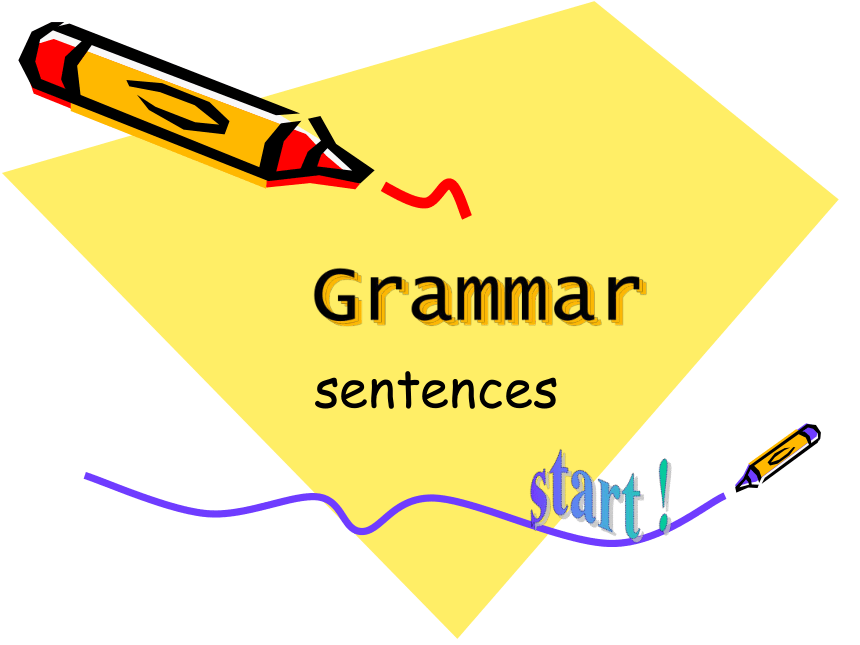 | |
| 格式 | pptx | ||
| 文件大小 | 949.3KB | ||
| 资源类型 | 教案 | ||
| 版本资源 | 牛津译林版(2019) | ||
| 科目 | 英语 | ||
| 更新时间 | 2024-10-08 16:21:40 | ||
图片预览

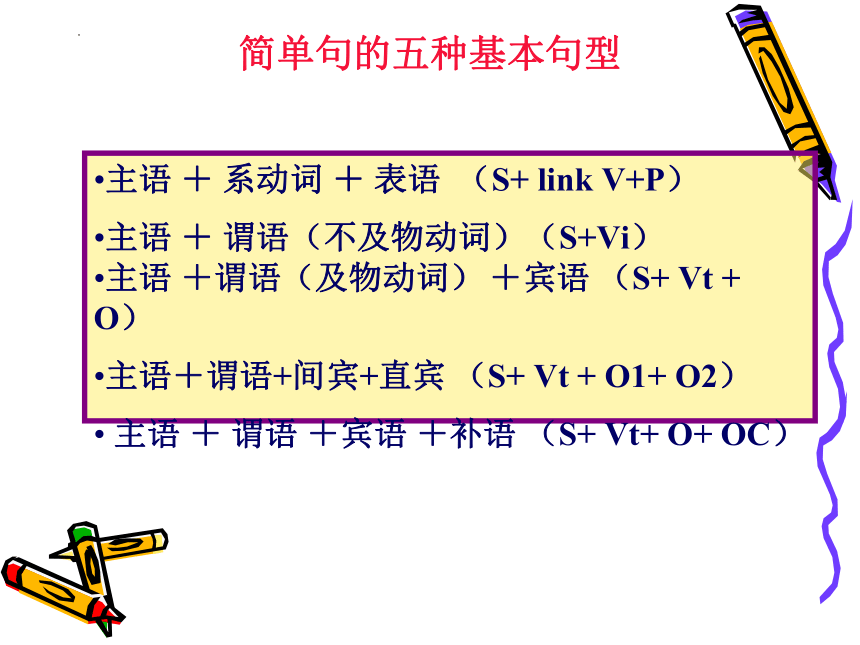
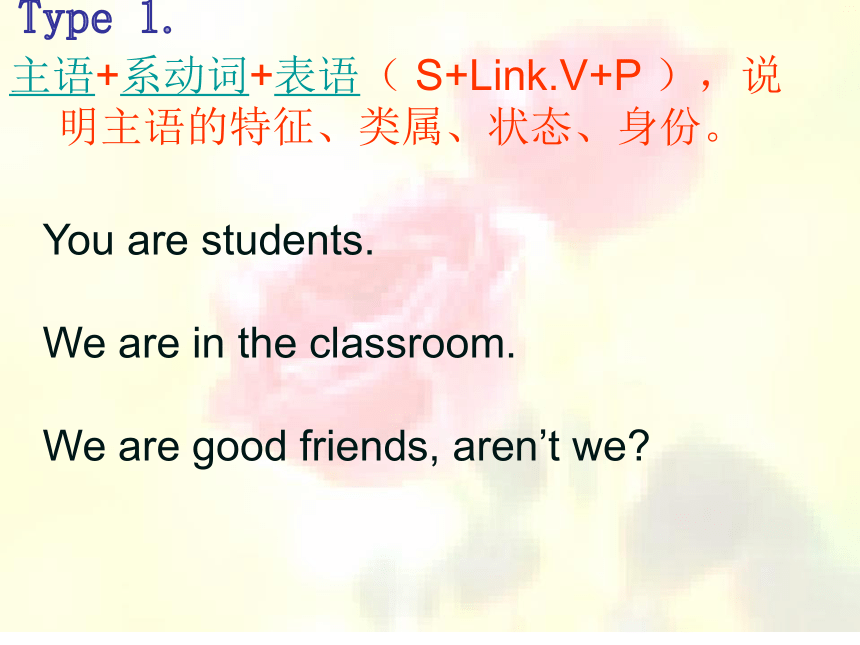

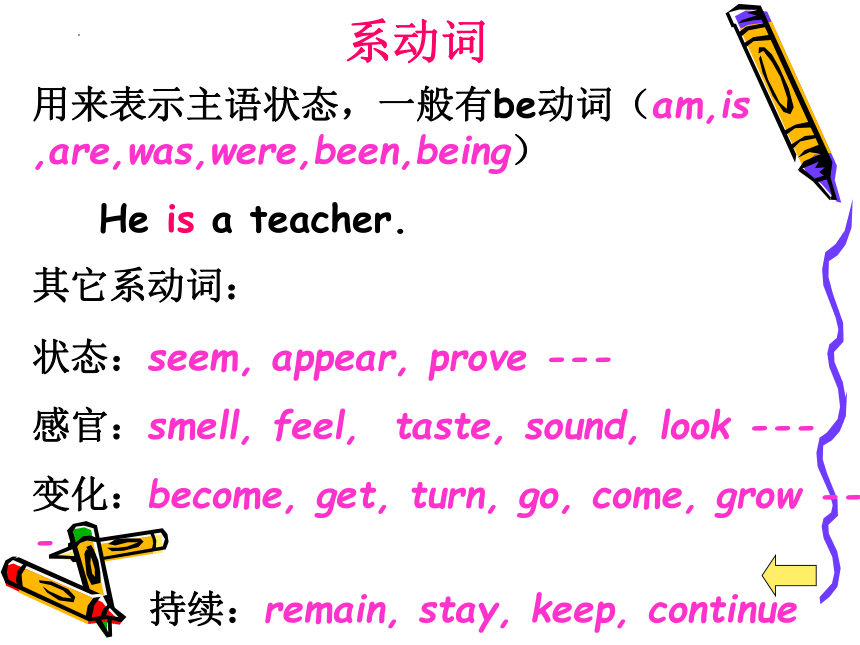
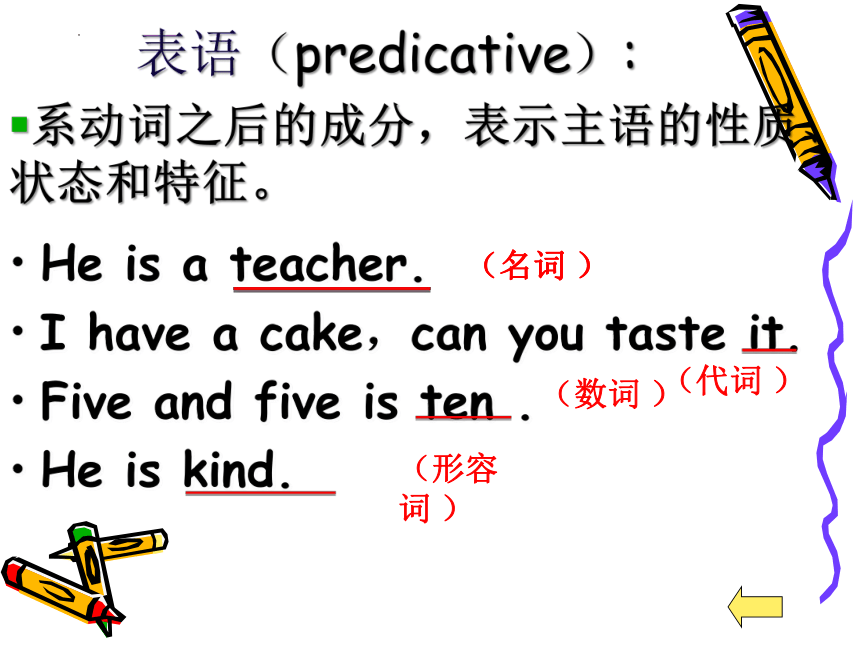
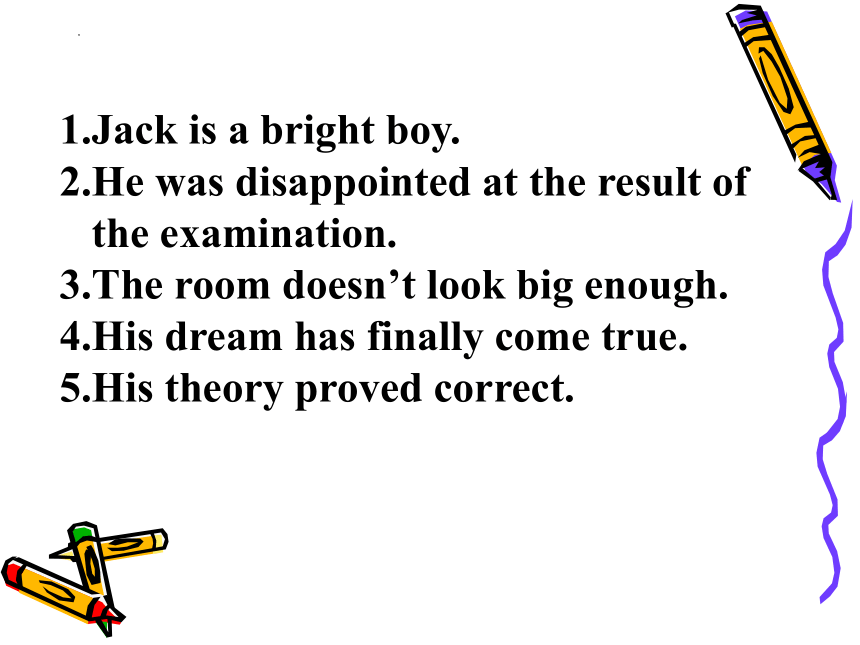
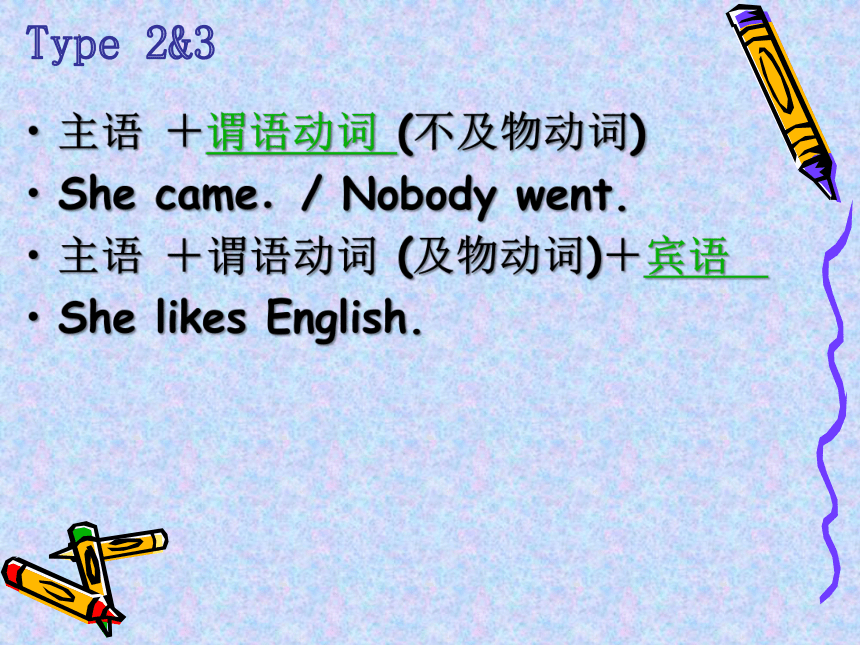
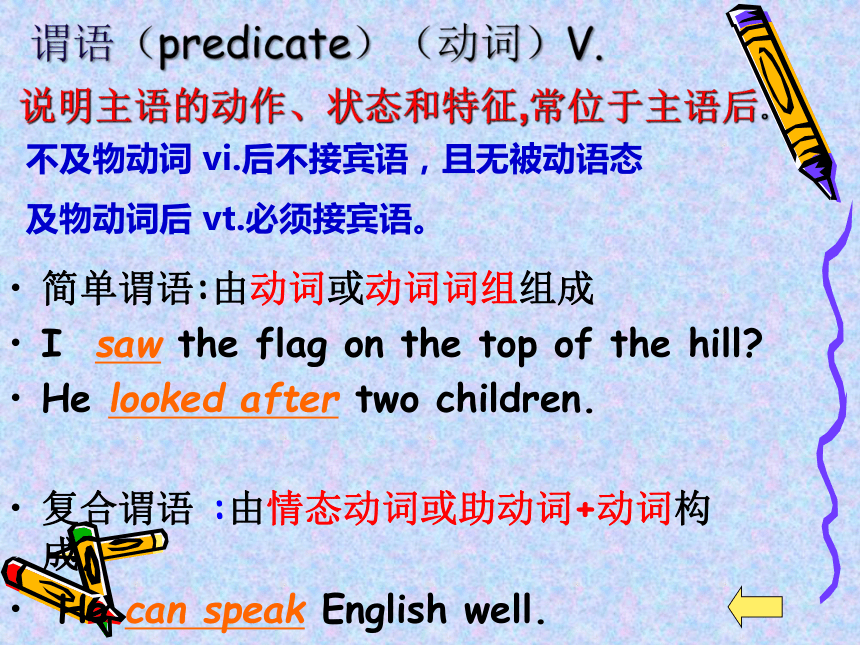
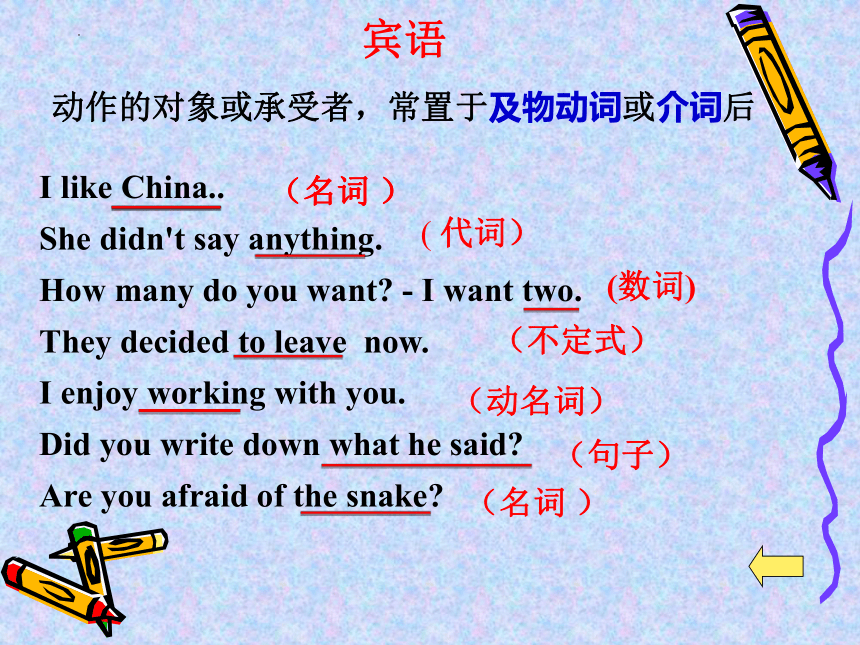
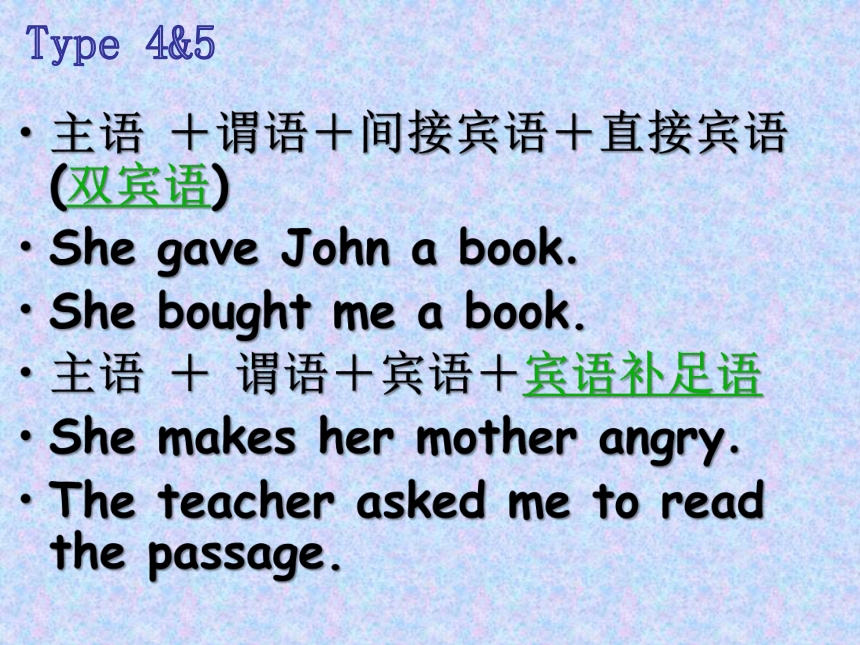
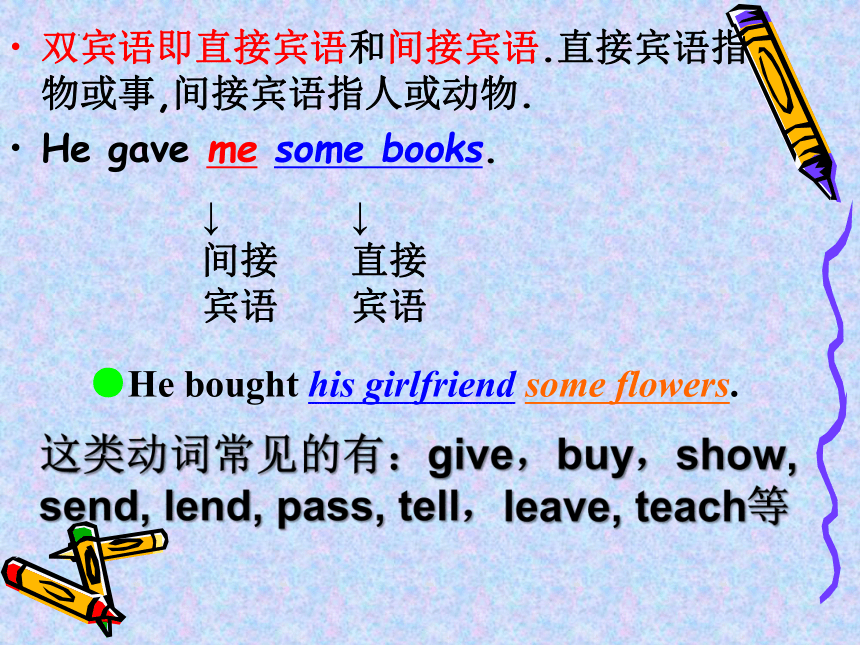
文档简介
(共45张PPT)
Grammar
sentences
start !
主语 + 系动词 + 表语 (S+ link V+P)
主语 + 谓语(不及物动词)(S+Vi)
主语 +谓语(及物动词) +宾语 (S+ Vt + O)
主语+谓语+间宾+直宾 (S+ Vt + O1+ O2)
主语 + 谓语 +宾语 +补语 (S+ Vt+ O+ OC)
简单句的五种基本句型
主语+系动词+表语( S+Link.V+P ),说
明主语的特征、类属、状态、身份。
You are students.
We are in the classroom.
We are good friends, aren’t we
Type 1.
主语(subject):
The sun rises in the east.
He likes dancing.
Twenty years is a short time in history.
Exercising is a good habit.
To see is to believe.
句子说明的人或物,常位于句首。
(名词 )
(代词 )
(数词 )
(动名词 )
(不定式 )
用来表示主语状态,一般有be动词(am,is ,are,was,were,been,being)
He is a teacher.
其它系动词:
状态:seem, appear, prove ---
感官:smell, feel, taste, sound, look ---
变化:become, get, turn, go, come, grow ---
持续:remain, stay, keep, continue
系动词
表语(predicative):
He is a teacher.
I have a cake,can you taste it.
Five and five is ten .
He is kind.
系动词之后的成分,表示主语的性质、状态和特征。
(名词 )
(名词 )
(代词 )
(数词 )
(形容词 )
Jack is a bright boy.
He was disappointed at the result of the examination.
The room doesn’t look big enough.
His dream has finally come true.
His theory proved correct.
主语 +谓语动词 (不及物动词)
She came./ Nobody went.
主语 +谓语动词 (及物动词)+宾语
She likes English.
Type 2&3
简单谓语:由动词或动词词组组成
I saw the flag on the top of the hill
He looked after two children.
复合谓语 :由情态动词或助动词+动词构成;
He can speak English well.
She doesn’t like dancing
谓语(predicate)(动词)V.
说明主语的动作、状态和特征,常位于主语后。
不及物动词 vi.后不接宾语,且无被动语态
及物动词后 vt.必须接宾语。
I like China..
She didn't say anything.
How many do you want - I want two.
They decided to leave now.
I enjoy working with you.
Did you write down what he said
Are you afraid of the snake
(名词 )
( 代词)
(数词)
宾语
动作的对象或承受者,常置于及物动词或介词后
(不定式)
(动名词)
(句子)
(名词 )
(名词 )
主语 +谓语+间接宾语+直接宾语 (双宾语)
She gave John a book.
She bought me a book.
主语 + 谓语+宾语+宾语补足语
She makes her mother angry.
The teacher asked me to read the passage.
Type 4&5
双宾语即直接宾语和间接宾语.直接宾语指物或事,间接宾语指人或动物.
He gave me some books.
↓
间接
宾语
↓
直接
宾语
●He bought his girlfriend some flowers.
这类动词常见的有:give,buy,show, send, lend, pass, tell,leave, teach等
找句中的直接宾语和间接宾语
① Please tell us a story.
② My father bought a new bike for me last week.
③ Mr. Li is going to teach us history next term.
④ Here is a pen. Give it to Tom.
⑤ Did he leave any message for me
宾补:宾语补足语
We will make them happy.
She always keeps her hair short.
补充说明宾语的情况,与宾语存在逻辑关系 。
这类动词常见的有: keep, make, let, have等.
↓
宾语
↓
宾补
② He asked her to take the boy out of school.
③ She found it difficult to do the work.
④ They call me Lily sometimes.
⑤ I saw Mr. Wang get on the bus.
挑出下列句中的宾语补足语
I met my best friend at the station
↓
主语
↓
谓
语
↓
定语
↓
宾
语
↓
状
语
定语(attributive)
对名词或代词起修饰、限定作用的词、短语或句子,汉语中常翻译成‘……的’。
The black bike is mine.
( )
Mr. Li is a history teacher.
He is our friend.
He was advised to teach the lazy boy a lesson.
You should do everything that I do.
(名词 )
(代词 )
(形容词 )
(定语从句 )
*当定语修饰不定代词如:nothing , anything ,
everything , something 等时,定语要放在其后作后置定语 。
定义:修饰名词或代词的词、短语或从句称为定语。
单词作定语时通常放在它所修饰的名词之_____;短语和从句作定语时则放在它所修饰的名词之_____。
前
后
状语(adverbial)
用以修饰adj. /v. /adv.及全句,位置灵活。表示时间、地点、原因、目的、结果、程度、条件、方式和让步.
1.修饰形容词或副词时,通常位于被修饰的词之前;
2.表示时间、地点、目的的状语一般位于句子两头,强调时放在句首,
3.一些表示不确定时间(如:often)或程度(如:almost)的副词状语通常位于be动词、助动词、情态动词之后,动词之前。
We often help him.
I am very sorry.
At 8, I ate my breakfast.
= I ate my breakfast at 8
状语:
I will go there tomorrow. 时间
The meeting will be held in the meeting room. 地点
The meat went bad because of the hot weather. 原因
He studies hard to learn English well. 目的
He didn’t study hard so that he failed in the exam.结果
I like some of you very much. 程度
If you study hard, you will pass the exam. 条件
He goes to school by bike. 方式
Though he is young, he can do it well. 让步
There be 结构
1、定义:There be句型表示某处存在某物或某人。
2、结构:(1) There is +单数可数名词/不可数名词 + 地点状语.
(2) There are +复数名词+地点状语.
* there是引导词,在句中不充当任何成分。句子的主语是某人或某物,谓语动词be要与主语(某人或某物)的数保持一致。当主语是两个或两个以上的名词时,谓语动词要与跟它最近的那个名词一致(就近原则)。
① There is a bird in the tree. 树上有一只鸟。
② There is a teacher and many students in our classroom. 我们教室里有一位老师和许多学生。
Ⅰ.简单句
1. Things changed.
2. Trees are green.
3. We don’t beat children.
4. He gave his sister the piano.
5. I found the book easy.
主 + 谓
主 + 谓 + 表
主 + 谓 + 宾
主 + 谓 + 间接宾语 + 直接宾语
主 + 谓 + 宾 + 宾补
Nobody went.
She became a doctor.
The car got fire.
I will write you a long letter.
I will let him go.
Practice
主 + 谓
主 + 系 + 表
主 + 谓 + 宾
主 + 谓 + 间接宾语 + 直接宾语
主 + 谓 + 宾 + 宾补
I don't like the picture on the wall.
don't B. like C. picture D. wall
2.Do you usually go to school by bus
A. Do B. usually C. go D. bus
3.There will be a meeting at the library this afternoon.
will be B. meeting
C. the library D. afternoon
4.People all over the world speak English.
people B. all over the world
C. speak D. English
句子类型
简单句
并列句
复合句
Ⅰ.简单句
1. Things changed.
2. Trees are green.
3. We don’t beat children.
4. He gave his sister the piano.
5. I found the book easy.
主 + 谓
主 + 谓 + 表
主 + 谓 + 宾
主 + 谓 + 间接宾语 + 直接宾语
主 + 谓 + 宾 + 宾补
Ⅱ.并列句
This is me and these are my friends.
They must stay in water, or they will die.
It’s not cheap, but it is very good.
It was late, so I went to bed.
and
or
but
so
He knocked at the door; there was no answer.
You’re alive! And she’s dead.
名词性从句
状语从句
定语从句
主语从句
表语从句
宾语从句
同位语从句
Ⅲ.复合句
A plane is a machine that can fly.
He said that he didn’t like her.
状语从句
分为九类:时间、地点、原因、结果、
目的、条件、让步、方式、程度
1) 时间状语从句
Wait until you are called.
When spring came, leaves turn green.
常用的关联词有:as, after, before, since,
till/ until, when, while, as soon as, whenever等
2) 地点状语从句
Put it where you found it.
Sit down wherever you like.
常用的关联词有:where, wherever, anywhere
3) 原因状语从句
As I didn’t know the way, I asked a policeman
常用的关联词有:because, as, since
4) 结果状语从句
I was in the bath so that I didn’t hear
the telephone.
常用的关联词有:so, so that, such that, that
5) 目的状语从句
I’ll show you so you will see how it’s done.
常用的关联词有:so, so that, in order that
6) 条件状语从句
If it snows tomorrow, we will build a snowman.
常用的关联词有:if, unless, in case that,
on condition that…
常用的关联词有:though, although, if
even if, even though,
7) 让步状语从句
Though I’m fond of music,I can’t play any instrument.
常用的关联词有:as, as if, as though, how
常用的关联词有:so, so that, as far as,
so long as
8) 方式状语从句
He did just as you told him.
9) 程度状语从句
So long as you need me, I’ll stay.
Homework
1.复习今天所学的句子结构
2.自行复习名词性从句的内容(必修三)
3.看试卷,做相应知识点.
名词性从句
1) 主语从句
* What he said is not known.
* That we shall be late is certain.
* It is certain that we shall be late.
* How strange it is that the children are so quiet!
2)表语从句
* That is what he wants to buy.
* The problem is that who we can get to replace her
* The reason is that he has lied to me several times.
3) 宾语从句
* I understand that he is well qualified.
* He said that he didn’t like her.
* I don’t know if you can help me.
4) 同位语从句
* Where did you get the idea
that I couldn’t come
* The question who should do the work
requires consideration.
* Mother made a promise
that she would buy me a new coat.
the idea
The question
a promise
注意!
* that与what都可以引导名词性从句。
* what在从句中充当句子成份(主,宾,表)。
* That在句中只起连接作用,不充当成份。
* that在引导名词性从句时不可省略(宾语从句除外).
That is what he wants to buy.
That we shall be late is certain.
He said (that) he didn’t like her.
引导词that & what
状语从句
分为九类:时间、地点、原因、结果、
目的、条件、让步、方式、程度
1) 时间状语从句
Wait until you are called.
When spring came, leaves turn green.
常用的关联词有:as, after, before, since,
till/ until, when, while, as soon as, whenever等
2) 地点状语从句
Put it where you found it.
Sit down wherever you like.
常用的关联词有:where, wherever, anywhere
3) 原因状语从句
As I didn’t know the way, I asked a policeman
常用的关联词有:because, as, since
4) 结果状语从句
I was in the bath so that I didn’t hear
the telephone.
常用的关联词有:so, so that, such that, that
5) 目的状语从句
I’ll show you so you will see how it’s done.
常用的关联词有:so, so that, in order that
6) 条件状语从句
If it snows tomorrow, we will build a snowman.
常用的关联词有:if, unless, in case that,
on condition that…
常用的关联词有:though, although, if
even if, even though,
7) 让步状语从句
Though I’m fond of music,I can’t play any instrument.
常用的关联词有:as, as if, as though, how
常用的关联词有:so, so that, as far as,
so long as
8) 方式状语从句
He did just as you told him.
9) 程度状语从句
So long as you need me, I’ll stay.
Grammar
sentences
END !
Grammar
sentences
start !
主语 + 系动词 + 表语 (S+ link V+P)
主语 + 谓语(不及物动词)(S+Vi)
主语 +谓语(及物动词) +宾语 (S+ Vt + O)
主语+谓语+间宾+直宾 (S+ Vt + O1+ O2)
主语 + 谓语 +宾语 +补语 (S+ Vt+ O+ OC)
简单句的五种基本句型
主语+系动词+表语( S+Link.V+P ),说
明主语的特征、类属、状态、身份。
You are students.
We are in the classroom.
We are good friends, aren’t we
Type 1.
主语(subject):
The sun rises in the east.
He likes dancing.
Twenty years is a short time in history.
Exercising is a good habit.
To see is to believe.
句子说明的人或物,常位于句首。
(名词 )
(代词 )
(数词 )
(动名词 )
(不定式 )
用来表示主语状态,一般有be动词(am,is ,are,was,were,been,being)
He is a teacher.
其它系动词:
状态:seem, appear, prove ---
感官:smell, feel, taste, sound, look ---
变化:become, get, turn, go, come, grow ---
持续:remain, stay, keep, continue
系动词
表语(predicative):
He is a teacher.
I have a cake,can you taste it.
Five and five is ten .
He is kind.
系动词之后的成分,表示主语的性质、状态和特征。
(名词 )
(名词 )
(代词 )
(数词 )
(形容词 )
Jack is a bright boy.
He was disappointed at the result of the examination.
The room doesn’t look big enough.
His dream has finally come true.
His theory proved correct.
主语 +谓语动词 (不及物动词)
She came./ Nobody went.
主语 +谓语动词 (及物动词)+宾语
She likes English.
Type 2&3
简单谓语:由动词或动词词组组成
I saw the flag on the top of the hill
He looked after two children.
复合谓语 :由情态动词或助动词+动词构成;
He can speak English well.
She doesn’t like dancing
谓语(predicate)(动词)V.
说明主语的动作、状态和特征,常位于主语后。
不及物动词 vi.后不接宾语,且无被动语态
及物动词后 vt.必须接宾语。
I like China..
She didn't say anything.
How many do you want - I want two.
They decided to leave now.
I enjoy working with you.
Did you write down what he said
Are you afraid of the snake
(名词 )
( 代词)
(数词)
宾语
动作的对象或承受者,常置于及物动词或介词后
(不定式)
(动名词)
(句子)
(名词 )
(名词 )
主语 +谓语+间接宾语+直接宾语 (双宾语)
She gave John a book.
She bought me a book.
主语 + 谓语+宾语+宾语补足语
She makes her mother angry.
The teacher asked me to read the passage.
Type 4&5
双宾语即直接宾语和间接宾语.直接宾语指物或事,间接宾语指人或动物.
He gave me some books.
↓
间接
宾语
↓
直接
宾语
●He bought his girlfriend some flowers.
这类动词常见的有:give,buy,show, send, lend, pass, tell,leave, teach等
找句中的直接宾语和间接宾语
① Please tell us a story.
② My father bought a new bike for me last week.
③ Mr. Li is going to teach us history next term.
④ Here is a pen. Give it to Tom.
⑤ Did he leave any message for me
宾补:宾语补足语
We will make them happy.
She always keeps her hair short.
补充说明宾语的情况,与宾语存在逻辑关系 。
这类动词常见的有: keep, make, let, have等.
↓
宾语
↓
宾补
② He asked her to take the boy out of school.
③ She found it difficult to do the work.
④ They call me Lily sometimes.
⑤ I saw Mr. Wang get on the bus.
挑出下列句中的宾语补足语
I met my best friend at the station
↓
主语
↓
谓
语
↓
定语
↓
宾
语
↓
状
语
定语(attributive)
对名词或代词起修饰、限定作用的词、短语或句子,汉语中常翻译成‘……的’。
The black bike is mine.
( )
Mr. Li is a history teacher.
He is our friend.
He was advised to teach the lazy boy a lesson.
You should do everything that I do.
(名词 )
(代词 )
(形容词 )
(定语从句 )
*当定语修饰不定代词如:nothing , anything ,
everything , something 等时,定语要放在其后作后置定语 。
定义:修饰名词或代词的词、短语或从句称为定语。
单词作定语时通常放在它所修饰的名词之_____;短语和从句作定语时则放在它所修饰的名词之_____。
前
后
状语(adverbial)
用以修饰adj. /v. /adv.及全句,位置灵活。表示时间、地点、原因、目的、结果、程度、条件、方式和让步.
1.修饰形容词或副词时,通常位于被修饰的词之前;
2.表示时间、地点、目的的状语一般位于句子两头,强调时放在句首,
3.一些表示不确定时间(如:often)或程度(如:almost)的副词状语通常位于be动词、助动词、情态动词之后,动词之前。
We often help him.
I am very sorry.
At 8, I ate my breakfast.
= I ate my breakfast at 8
状语:
I will go there tomorrow. 时间
The meeting will be held in the meeting room. 地点
The meat went bad because of the hot weather. 原因
He studies hard to learn English well. 目的
He didn’t study hard so that he failed in the exam.结果
I like some of you very much. 程度
If you study hard, you will pass the exam. 条件
He goes to school by bike. 方式
Though he is young, he can do it well. 让步
There be 结构
1、定义:There be句型表示某处存在某物或某人。
2、结构:(1) There is +单数可数名词/不可数名词 + 地点状语.
(2) There are +复数名词+地点状语.
* there是引导词,在句中不充当任何成分。句子的主语是某人或某物,谓语动词be要与主语(某人或某物)的数保持一致。当主语是两个或两个以上的名词时,谓语动词要与跟它最近的那个名词一致(就近原则)。
① There is a bird in the tree. 树上有一只鸟。
② There is a teacher and many students in our classroom. 我们教室里有一位老师和许多学生。
Ⅰ.简单句
1. Things changed.
2. Trees are green.
3. We don’t beat children.
4. He gave his sister the piano.
5. I found the book easy.
主 + 谓
主 + 谓 + 表
主 + 谓 + 宾
主 + 谓 + 间接宾语 + 直接宾语
主 + 谓 + 宾 + 宾补
Nobody went.
She became a doctor.
The car got fire.
I will write you a long letter.
I will let him go.
Practice
主 + 谓
主 + 系 + 表
主 + 谓 + 宾
主 + 谓 + 间接宾语 + 直接宾语
主 + 谓 + 宾 + 宾补
I don't like the picture on the wall.
don't B. like C. picture D. wall
2.Do you usually go to school by bus
A. Do B. usually C. go D. bus
3.There will be a meeting at the library this afternoon.
will be B. meeting
C. the library D. afternoon
4.People all over the world speak English.
people B. all over the world
C. speak D. English
句子类型
简单句
并列句
复合句
Ⅰ.简单句
1. Things changed.
2. Trees are green.
3. We don’t beat children.
4. He gave his sister the piano.
5. I found the book easy.
主 + 谓
主 + 谓 + 表
主 + 谓 + 宾
主 + 谓 + 间接宾语 + 直接宾语
主 + 谓 + 宾 + 宾补
Ⅱ.并列句
This is me and these are my friends.
They must stay in water, or they will die.
It’s not cheap, but it is very good.
It was late, so I went to bed.
and
or
but
so
He knocked at the door; there was no answer.
You’re alive! And she’s dead.
名词性从句
状语从句
定语从句
主语从句
表语从句
宾语从句
同位语从句
Ⅲ.复合句
A plane is a machine that can fly.
He said that he didn’t like her.
状语从句
分为九类:时间、地点、原因、结果、
目的、条件、让步、方式、程度
1) 时间状语从句
Wait until you are called.
When spring came, leaves turn green.
常用的关联词有:as, after, before, since,
till/ until, when, while, as soon as, whenever等
2) 地点状语从句
Put it where you found it.
Sit down wherever you like.
常用的关联词有:where, wherever, anywhere
3) 原因状语从句
As I didn’t know the way, I asked a policeman
常用的关联词有:because, as, since
4) 结果状语从句
I was in the bath so that I didn’t hear
the telephone.
常用的关联词有:so, so that, such that, that
5) 目的状语从句
I’ll show you so you will see how it’s done.
常用的关联词有:so, so that, in order that
6) 条件状语从句
If it snows tomorrow, we will build a snowman.
常用的关联词有:if, unless, in case that,
on condition that…
常用的关联词有:though, although, if
even if, even though,
7) 让步状语从句
Though I’m fond of music,I can’t play any instrument.
常用的关联词有:as, as if, as though, how
常用的关联词有:so, so that, as far as,
so long as
8) 方式状语从句
He did just as you told him.
9) 程度状语从句
So long as you need me, I’ll stay.
Homework
1.复习今天所学的句子结构
2.自行复习名词性从句的内容(必修三)
3.看试卷,做相应知识点.
名词性从句
1) 主语从句
* What he said is not known.
* That we shall be late is certain.
* It is certain that we shall be late.
* How strange it is that the children are so quiet!
2)表语从句
* That is what he wants to buy.
* The problem is that who we can get to replace her
* The reason is that he has lied to me several times.
3) 宾语从句
* I understand that he is well qualified.
* He said that he didn’t like her.
* I don’t know if you can help me.
4) 同位语从句
* Where did you get the idea
that I couldn’t come
* The question who should do the work
requires consideration.
* Mother made a promise
that she would buy me a new coat.
the idea
The question
a promise
注意!
* that与what都可以引导名词性从句。
* what在从句中充当句子成份(主,宾,表)。
* That在句中只起连接作用,不充当成份。
* that在引导名词性从句时不可省略(宾语从句除外).
That is what he wants to buy.
That we shall be late is certain.
He said (that) he didn’t like her.
引导词that & what
状语从句
分为九类:时间、地点、原因、结果、
目的、条件、让步、方式、程度
1) 时间状语从句
Wait until you are called.
When spring came, leaves turn green.
常用的关联词有:as, after, before, since,
till/ until, when, while, as soon as, whenever等
2) 地点状语从句
Put it where you found it.
Sit down wherever you like.
常用的关联词有:where, wherever, anywhere
3) 原因状语从句
As I didn’t know the way, I asked a policeman
常用的关联词有:because, as, since
4) 结果状语从句
I was in the bath so that I didn’t hear
the telephone.
常用的关联词有:so, so that, such that, that
5) 目的状语从句
I’ll show you so you will see how it’s done.
常用的关联词有:so, so that, in order that
6) 条件状语从句
If it snows tomorrow, we will build a snowman.
常用的关联词有:if, unless, in case that,
on condition that…
常用的关联词有:though, although, if
even if, even though,
7) 让步状语从句
Though I’m fond of music,I can’t play any instrument.
常用的关联词有:as, as if, as though, how
常用的关联词有:so, so that, as far as,
so long as
8) 方式状语从句
He did just as you told him.
9) 程度状语从句
So long as you need me, I’ll stay.
Grammar
sentences
END !
